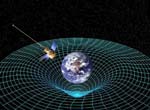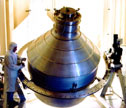WEEKLY UPDATE FOR 9 SEPTEMBER 2005:
GRAVITY PROBE B MISSION STATUS AT A GLANCE

| Item | Current Status |
| Mission Elapsed Time | 507 days (72 weeks/16.6 months) |
IOC Phase |
129 days (4.2 months) |
Science Phase |
352 days (11.6 months) |
Final Calibration Phase |
26 days |
| Current Orbit # | 7,482 as of 4:30 PM PST |
| Spacecraft General Health | Good |
| Roll Rate | Normal at 0.7742 rpm (77.5 seconds per revolution) |
| Gyro Suspension System (GSS) | All 4 gyros digitally suspended |
| Dewar Temperature | 1.82 kelvin, holding steady |
| Global Positioning System (GPS) lock | Greater than 96.5% |
| Attitude & Translation Control (ATC) | X-axis attitude error: 149.7 marcs rms |
| Command & Data Handling (CDH) | B-side (backup) computer in control Multi-bit errors (MBE): 0 Single-bit errors (SBE): 8 (daily average) |
| Telescope Readout (TRE) | Nominal |
| SQUID Readouts (SRE) | Nominal |
| Gyro #1 rotor potential | +2.4 mV |
| Gyro #2 rotor potential | +1.7 mV |
| Gyro #3 rotor potential | +0.5 mV |
| Gyro #4 rotor potential | +2.6 mV |
| Gyro #1 Drag-free Status | Backup Drag-free mode (OFF during some calibration tests) |
MISSION DIRECTOR'S SUMMARY
On Mission Day 507, the Gravity Probe B vehicle and payload are in good health and all subsystems are performing nominally.
The helium in the Dewar has lasted throughout this past week, and thus we have continued with the calibration tests that we began over three weeks ago. These tests involve slewing the telescope (and spacecraft) to “visit” stars (both real and virtual) in the neighborhood around the guide star, IM Pegasi. In each case, we visit a neighboring location for a period of time and then lock back onto IM Pegasi for several hours. The purpose of these tests is to calibrate, in detail, the torques imparted onto the science gyroscopes by purposely mis-aligning the telescope (and spacecraft roll axis) from the direction of the gyro spin axes.



Last weekend, we visited a "virtual star" (location where no stars visible to the telescope exist) located 0.1 degree in the direction of neighboring star HD 216635, northwest of IM Pegasi. We remained at this location for 24 hours and then returned to IM Pegasi for 16 hours. We then repeated this procedure, visiting a location 0.1 degrees in the opposite direction. Then, this past Tuesday we visited a virtual star location halfway to the Star HR Pegasi (HD 216672), which is located to the west of IM Pegasi. After dwelling in that location for 24 hours, we again returned to IM Pegasi. And, on Thursday, we visited a virtual location 0.3 degrees towards HD 216635, remained there for 24 hours and then returned to IM Pegasi.

This coming weekend, if we still have helium remaining, we will visit similar virtual star locations, or possibly real stars, within a 4-degree radius of IM Pegasi, each time visiting a neighboring location for several hours and then returning to IM Pegasi. And, as long as there is still helium, we will continue similar tests into next week…and beyond.
GP-B MISSION NEWS—THE HELIUM JUST KEEPS ON FLOWING…
Like Energizer Bunny® that “keeps on going,” the helium in the GP-B Dewar just keeps on flowing. Our Dewar specialists assure us that we are, indeed, well into the final days--or possibly hours--of helium. But when will the helium actually run out? That's anybody's guess (we have a pool going amongst the remaining team members here at Stanford).


Estimating the amount of liquid helium remaining in a 650 gallon Thermos bottle, orbiting 400 miles above the Earth, requires complex calculations, and there are many variables at play. Also, there is a considerable margin of error in these calculations. Our GP-B Dewar specialists, who modeled the Dewar's life cycle and have been tracking its performance, have purposely remained conservative in their longevity estimates of the helium, so as to ensure that there would be enough helium to perform the most important calibration tests.
Following the initial tests, we have been working our way through a prioritized list of further tests that will be beneficial in analyzing the science data. As long as the helium continues to flow, we will continue working our way through this list. The consensus here is that the helium will very likely run out by the beginning of next week. But, if it lasts longer, we will simply continue performing these tests.
When the helium actually does run out, we will post a notice on our Web site and send out a message to the subscribers of our GP-B Update email list. NASA will also issue a news release, and we will then post the content of that release on our Web site and send it to our email subscribers. Stay tuned….
UPDATED NASA/GP-B FACT SHEET AVAILABLE FOR DOWNLOADING
We recently updated our NASA Factsheet on the GP-B mission and experiment. You'll now find this 6-page document (Adobe Acrobat PDF format) listed as the last navigation link under "What is GP-B" in the upper left corner of this Web page. You can also click here to download a copy.
Drawings & Photos: The layered composite photo of the GP-B spacecraft orbiting through Earth's gravitational field was created by GP-B Public Affairs Coordinator, Bob Kahn, using Adobe Photoshop and Adobe Illustrator. The photo of the Dewar was taken by Lockheed Martin photographer Russ Underwood. The photo of the porous plug and the chart showing the real and virtual stars recently visited are from the GP-B Image Archive here at Stanford. The sky chart images, showing the guide star IM Pegasi and its neighboring stars, were generated by the Voyager III Sky Simulator from Carina Software. Click on the thumbnails to view these images at full size.
MORE LINKS ON RECENT TOPICS
- Track the satellite in the sky
- Photo, video & and news links
- Build a paper model of the GP-B Spacecraft
- Following the mission online
- Our mailing list—receive the weekly highlights via email
- The GP-B Launch Companion in Adobe Acrobat PDF format. Please note: this file is 1.6 MB, so it may take awhile to download if you have a slow Internet connection.
Previous Highlight
Index of Highlights
